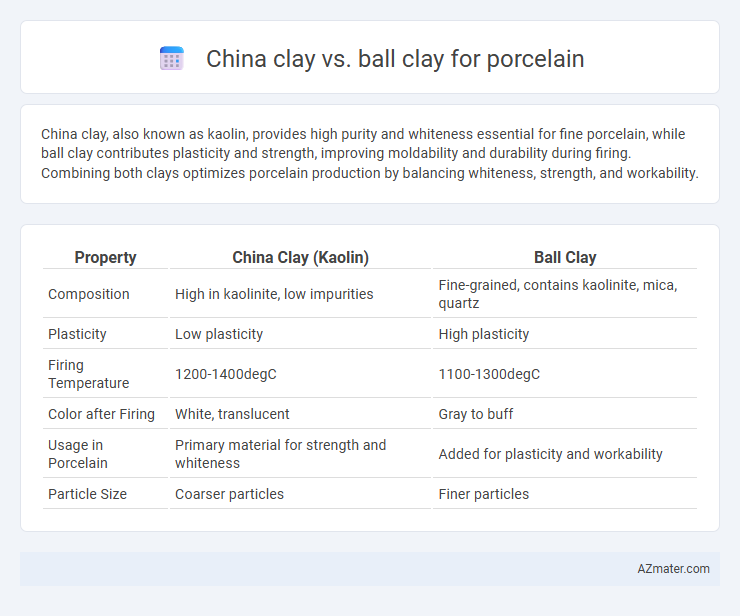China clay, also known as kaolin, provides high purity and whiteness essential for fine porcelain, while ball clay contributes plasticity and strength, improving moldability and durability during firing. Combining both clays optimizes porcelain production by balancing whiteness, strength, and workability.
Table of Comparison
| Property | China Clay (Kaolin) | Ball Clay |
|---|---|---|
| Composition | High in kaolinite, low impurities | Fine-grained, contains kaolinite, mica, quartz |
| Plasticity | Low plasticity | High plasticity |
| Firing Temperature | 1200-1400degC | 1100-1300degC |
| Color after Firing | White, translucent | Gray to buff |
| Usage in Porcelain | Primary material for strength and whiteness | Added for plasticity and workability |
| Particle Size | Coarser particles | Finer particles |
Introduction to China Clay and Ball Clay
China clay, also known as kaolin, is a primary clay mineral composed mainly of kaolinite, prized for its white color, purity, and high refractory properties, making it essential in porcelain production for its strength and translucency. Ball clay contains organic matter and other minerals like mica and quartz, giving it plasticity and workability, which improves the forming and shaping process in porcelain manufacturing. Both clays contribute uniquely to porcelain; china clay enhances whiteness and thermal resistance, while ball clay provides flexibility and green strength during shaping.
Geological Origin and Formation
China clay, also known as kaolin, originates primarily from the chemical weathering of feldspathic rocks such as granite under acidic conditions, resulting in a high-purity, white, and fine-grained aluminosilicate clay ideal for porcelain production. Ball clay forms from secondary sedimentation processes, where fine particles are transported and deposited in low-energy environments like river basins, leading to a plastic, highly plastic clay rich in organic matter and impurities but essential for enhancing the workability and strength of porcelain bodies. The contrasting geological origins--primary residual formation for China clay versus secondary sedimentary deposition for Ball clay--significantly influence their mineralogy and functional properties in ceramic manufacturing.
Chemical Composition Differences
China clay, also known as kaolin, primarily consists of the mineral kaolinite (Al2Si2O5(OH)4) with high alumina and silica content, providing excellent whiteness and plasticity essential for porcelain production. Ball clay contains a mixture of kaolinite, mica, and quartz, with higher levels of organic matter and fluxing oxides such as iron oxide, which lower the firing temperature but affect the color and translucency of porcelain. The chemical composition differences influence the porcelain's strength, whiteness, and vitrification, with china clay offering purity and brightness while ball clay contributes plasticity and workability.
Physical Properties Comparison
China clay, or kaolin, exhibits a fine particle size and high whiteness, providing excellent plasticity and strength, ideal for porcelain's translucent quality and durability. Ball clay has higher plasticity and greater particle size variation, offering superior workability but lower whiteness, which can affect the final porcelain color. The combination of both clays optimizes porcelain production by balancing whiteness, plasticity, and firing shrinkage for enhanced physical properties.
Plasticity and Workability in Porcelain
China clay, also known as kaolin, provides low plasticity and contributes to porcelain's strength and translucency but requires blending with more plastic clays to improve workability during shaping. Ball clay offers high plasticity and excellent workability, enabling intricate forming and better shaping of porcelain pieces without cracking. Combining china clay and ball clay optimizes the balance between porcelain's durability and ease of molding.
Impact on Firing Temperature
China clay, also known as kaolin, has a high melting point that helps maintain porcelain's strength and whiteness during firing at temperatures typically ranging from 1200degC to 1400degC. Ball clay contains higher amounts of organic materials and fluxing agents, which lower the firing temperature and increase plasticity but can lead to greater shrinkage and potential warping in the porcelain body. The balance between china clay and ball clay is crucial for optimizing firing temperature, ensuring durability, and achieving the desired translucency and surface finish in porcelain products.
Color and Surface Finish Results
China clay, also known as kaolin, produces porcelain with a bright white color and a smooth, refined surface finish due to its high purity and fine particle size. Ball clay contains higher amounts of impurities like iron and organic matter, resulting in a slightly off-white or creamy color and a denser, less translucent surface. The choice between china clay and ball clay directly impacts the porcelain's whiteness and surface texture, with china clay preferred for pristine, delicate finishes and ball clay favored for added plasticity and strength.
Role in Porcelain Body Formulation
China clay, also known as kaolin, provides crucial whiteness, plasticity, and refractory properties essential for porcelain body formulation, ensuring durability and translucency. Ball clay contributes high plasticity and workability, enhancing the porcelain's strength and moldability during shaping and firing. The balanced combination of china clay and ball clay optimizes mechanical strength, firing performance, and surface finish in porcelain production.
Industrial Sourcing and Availability
China clay, also known as kaolin, is widely used in porcelain manufacturing due to its high purity, whiteness, and plasticity, making it ideal for producing fine, durable ceramics. Ball clay offers superior plasticity and bonding capabilities but contains higher impurities, requiring careful blending to achieve optimal porcelain quality. Industrial sourcing favors China clay for large-scale production given its abundant global deposits, while ball clay's availability is more region-specific, affecting supply chain dynamics in porcelain manufacturing.
Choosing the Right Clay for Porcelain Production
China clay, also known as kaolin, offers high purity and a white firing color essential for fine porcelain, providing strength and translucency in the final product. Ball clay contains higher plasticity and fires to a slightly darker color, improving the workability and mechanical properties but requiring careful blend adjustments to maintain porcelain's characteristic whiteness and translucency. Selecting the right clay for porcelain production hinges on balancing china clay's purity with ball clay's plasticity to optimize strength, workability, and aesthetic quality in the finished ware.

Infographic: China clay vs Ball clay for Porcelain
 azmater.com
azmater.com